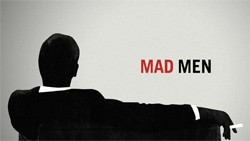Could it have anything to do with the main character’s backstory?
In the evening, when my brain has turned to slop, I turn on the TV.
I must have been a lawyer or police officer in my former life because my choice of programming is usually a drama series.
I prefer something with talented actors and, of course, an entertaining main character.
The other night, I watched another episode of the Mad Men series.
And it got me thinking.
Why do we root for the main character, even if they are a sleazeball?
Before watching Mad Men, I watched the Suits series.
In both series, the main character was a handsome, virile male. I’m talking about a face that titillates sweet dreams.
Yet, despite their handsome looks, both these main characters are a sleazeball in their own way.
Don Draper from Mad Men is a womanizer, and Harvey Specter, a lawyer, doesn’t always play by the rules.
Don from Mad Men, married with children, sleeps with seventeen women throughout the series.
Yet, despite their wrongdoings, I rooted for them to win every time something went wrong in their life, which was often because of all the episodes.
Have I gone soft in my old age, or is there something more psychologically deep-rooted for me to care about these characters?
Character development involves backstory
It’s essential to know everything about your main characters when developing them.
It’s essential to make them memorable characters.
It’s essential to add a timeline of historical events that shaped their emotional wounds and scars, besides their hair color and school.
With the Don Draper character, he took part in the Korean War.
You must create an intense history; your audience cannot help but root for the main character through to the end.
The clever thing about the Don Draper character in the episodes was that he did not want to talk about his past. He never discussed his history with his wife. Yet, that was the central part of his character. The secret past that could land him in jail for being a deserter.
As well as his troubled upbringing.
Don’t think you can write their backstory as you progress through your narrative.
If you write about your main character without understanding the depth of their wounds, how will you know how they will react in certain conditions?
What’s the best way to reveal the backstory
Bosch, by Michael Connelly, is one of my favorite characters.
Even though Bosch does not play a womanizer or even come under the category of being a sleazeball, he, too, has a heart-wrenching backstory.
So, how do you introduce your main character’s backstory without boring your audience?
Everyone has a backstory. It’s a given unless you grew up under a rock. Then again. You’d be afraid of the dark or dirt.
We don’t tell our close relatives or friends our backstory because they already know it.
You’re more likely to tell a stranger, right? Someone you’ve just met, and you want them to get to know you better.
The same runs true with your psychiatrist.
You don’t tell them everything about you in one sitting.
You split it into chunks, so the listener doesn’t get bored or overwhelmed, and they have time to analyze your reasoning for doing or saying something.
There are sections of my life I’d rather forget, and I’m sure you feel the same way?
Yet, those events have molded us into who we are today.
So, when writing about your main character, don’t introduce all their backstory in the first chapter or opening scene. It will only slow down the pace plus confuse or bore your audience.
A lengthy backstory revealed as a flashback can confuse your viewer. They need to remember what timeline the character is in.
Personally, I’m not a fan of flip-flopping timelines.
It confused me.
Then again, I’m easily confused.
When I went to the movies to watch Fried Green Tomatoes, I got lost in the story. But not in the way the screenwriter wanted me to be.
My mind was dizzy with the constant flashbacks.
Now, the worst thing you can do that will put your audience to sleep is to start your opening with too much backstory.
Today, novels and movies often start amid the action.
Even though backstory is crucial to a story’s development, sprinkle the flashbacks lightly in the beginning.
So, how do you introduce a main character who is flawed?
Delight your readers so they are desperate to know the backstory
Harvey Specter, Don Draper, and Harry Bosch hooked me because their characters are intriguing.
Their past events have affected their lives in such a way we can’t help but want to know more about what happened to them in their youth.
We find out that Harry Bosch’s mother was a prostitute. She’s murdered, and they did not catch her killer. Hence Bosch grew up in a foster home and became a detective.
At sixteen, Harvey Specter from Suits caught his mother cheating on his father.
His mother requested that he keep her secret.
His desire to spare his father’s feelings caused him to conceal her secret, but it led to the ruin of his relationship with his mother, the rest of his family, and his trust in women.
In Mad Men, Don Draper is the tearjerker of them all, despite portraying him as an unsympathetic character.
Dick’s mother was a prostitute and died in childbirth.
His abusive, alcoholic father and stepmother raised him on a farm. Dick’s father was killed by a frightened horse when he was ten, and he witnessed the incident.
During military service in the Korean War, Dick assumed the identity of Don Draper. The real Don Draper died in battle, and Dick took his identity. He deserted the war and created a new life for himself in New York.
When you position the backstory correctly in your story, it can be intriguing.
It often explains why the main character acted in a certain way under duress. Or why they fear snakes, as in the character Indiana Jones.
The most effective way to express backstory is through emotional recall, also known as flashbacks, but to keep them short and related to the dominant story.
Backstory always looms in the background of your main character’s mind, even in our minds. We never forget the past, no matter how we try.
If you’ve effectively developed your main character, your audience should feel an emotional bond with them.
Remember, your audience doesn’t need to know the full details of your main character’s backstory all at once. Because if it doesn’t move the plot forward, it doesn’t need to be told.
Don’t reveal too much backstory in the beginning
I’m sure you’re getting the gist of this post; backstory is crucial to developing your main character’s story, but don’t overdo it all at once.
But the more painful your main character’s backstory is, the more successful your novel or script will be.
As a writer, you should never create a perfect character.
No one on this earth is perfect. Everyone has flaws, even if they try to convince you otherwise.
Remember, we are who we are because of our past. Our backstory. And that needs to run true for our main character.
Avoid revealing their backstory in the opening scene to prevent information overload.
But you want your audience to know your main character has a backstory.
So, the best way to introduce a backstory in the beginning, so you don’t slow down the pace, is through dialogue.
Reveal a small section of their past in your main character’s conversation with a stranger.
Select a stranger because a friend or relative will already know the main characters’ past.
Choose someone they meet on a train or go on a blind date with. But keep it short, as you don’t want to slow down the pace.
Remember, to keep your audience entertained, there needs to be tension and drama in the dialogue.
I find it amusing. We try to avoid tension and drama in our lives; most of us do. Yet, we’re entertained on the screen by other people’s struggles.
If you choose to use your character’s thoughts to reveal their backstory, keep them short and interesting but relative to the situation.
Don’t have them think of a random thought. It needs to be related to current events.
Make sure you don’t confuse your reader with too many flashbacks
Personally, I prefer to read or watch a story that unfolds in a sequential timeline.
As I said, I’m easily confused.
Even though Fried Green Tomatoes won several awards, it wasn’t my favorite movie because of the constant flashbacks.
Revealing backstories as flashbacks can confuse and disrupt the flow of the story.
If you want to use a flashback and feel it will serve your story well, go for it. But inject it with as much narrative drive as your dominant story.
And before you ever use a flashback, make the reader desperate for it so it will explain why your main character reacted in such a way.
But in the end, it’s up to you, the writer, whether your main character overcomes his past, becomes the almighty hero, and saves the world.
Or their flawed past eats away at their soul and destroys them.
Excessive drinking or drugs is an indicator to your audience that your main character is floundering in reaching their goals.
Let’s wrap thing up
We spend more time with the main character and see the world from their perspective.
The backstory is a narrative history written in chronological order. It’s the history of the main character before the current drama began.
The backstory also helps build depth or believability in the main character and story.
This allows us to get to know them and understand their motivations, making it easier to sympathize with them.
Someone frequently confronted the main character with difficult hurdles. Make it easy to support them as they try to conquer life’s challenges.
Also, the main character is usually the most relatable, which can make it easy to root for them, and they are likable and have admirable traits.
So, craft an exciting plot that reveals your main characters’ secrets and causes your audience to care because of their painful backstory.




